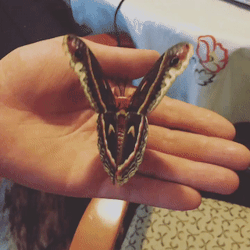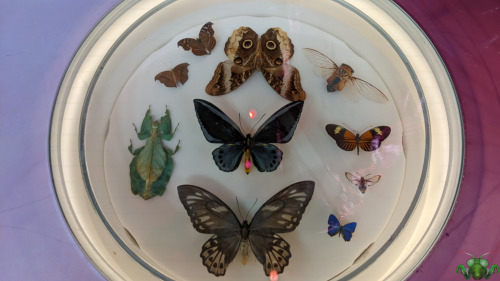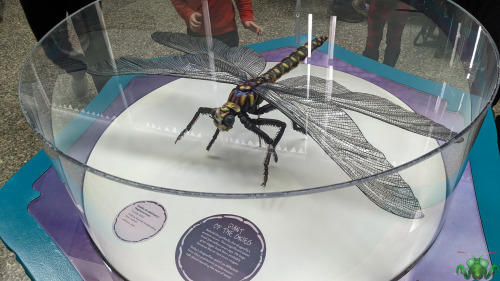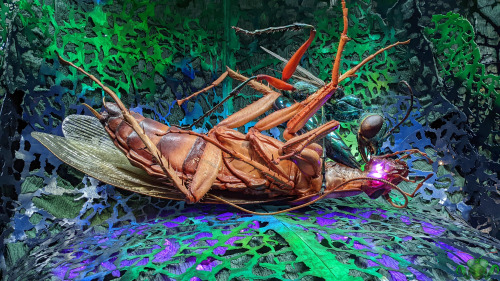#leaf insect
Giant leaf insects
Scientific name:Phyllium giganteum
Locality:West Malaysia, Pahang State, Kameron Highlands
Department:Entomology, image © California Academy of Science
Post link
Little Legs Cool Jabroni molted to L4 yesterday morning!
Lookit how big he’s gotten!!
only about 2 more instars before full adulthood, wiggle wiggle <3
Ontario Science Centre - Bug Lab 2022
Spoilers galore! These are some of the highlights of the Ontario Science Centre’sBug Lab Exhibition. This travelling exhibition was created by Te Papa, the museum of New Zealand in collaboration with Weta. It’s mostly geared towards children but there’s quite a bit here for all to enjoy, and I’m very grateful I was able to go. Yesterday was actually its last day in the OSC. This is an exhibition that I really think people should go to see when it arrives to their neck of the woods, so I won’t be sharing everything I’ve seen. Since these are exhibitions created by others, I’ve labelled them with the mantis logo and only take credit for the photography; the hard work and effort of this collaboration deserves all the spotlight it can, especially with all the wondrous displays! There are even interactive elements to enjoy such as magnifying glasses, touch screens and game parts. For myself, it’s all about the insects and what we can learn from them. I begin this showcase with the tribute to the Māori people that highlights how all life is connected and how insects have inspired them. You’ll have to discover those inspirations and life for yourself, but I can promise you they are all beautiful.
The showcase mentions that insects were created alongside “ugly things” by the gods, and so have included an insect native to New Zealand: the Weta, which often has a reputation for being called “ugly”. It may not be as traditionally appealing like other winged Orthopterans, it brings something more primal, powerful and wild to the fold; not something angry, but more like a old friend to the more temperature Grasshoppers. Important as that display is, children and visitors may be more drawn to the insect displays on showcase containing pinned insects and models. The pinned insect exhibits highlight the most prominent parts of the insect world to us: their biodiversity (including differences within even an order such as with Coleoptera), their beauty as seen with the showcase of winged insects, their evolutionary trajectory (as seen with an ancestor of modern day Odonates: the Griffinfly; 70cm wingspan) and how they can be used to benefit humanity. Insect wings were lighted as a marvel of design for flight technology and for the financial sector using Butterfly wing iridescence as inspiration (yay nanoholes). Swarming of insects even provides inspiration for drone movement and coordination with themselves! With all ideas, it’s amazing how inspiration can strike!
My favorite displays here are definitely the large models* of insects in their natural environment! The level of detail and story-telling is astonishing, especially with the Hymenopterans which is what I’d like to share! While a bit terrifying, we have a realization of how the Jewel WaspcapturesRoaches for its offspring. We call it brain surgery and the Waspcalls it incubation! Next to that, an intruder has found a hive and is marking it for the swarm! Fortunately, the hive’s defenders are ready for this scout and mobilize. There’s no secret to the power of the Asian Giant Hornet (and is the first true Hornet to grace this blog), but the Honeybees that live alongside it have adapted against it: they swarm the large intruder in coordination, form a Bee-ball and vibrate their bodies to generate heat to roast the Hornet. This exhibit even includes an interactive element to help generate heat to help the brave Bees! Though a few workers may fall defending their home, the colony lives in gratitude. Not yet safe however, the worker Bees also have to clean up the pheromone markers left by the scout so that other Hornets don’t pick up the trail. These are all astonishing feats of the natural world!
*Note: Other large models featured include displays of Dragonflies in flight and the camouflaging abilities of the Orchid Mantis (Hymenopus coronatus). You have to discover those for yourself.
Pictures were taken on February 20, 2022 at the Ontario Science Centre using a Google Pixel 4. Thank you for the Bugs!
Post link






















